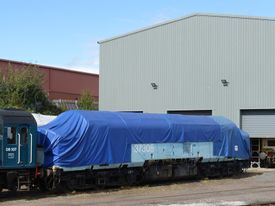BR Class 37 37308
| BR Class 37 37308 | |
|---|---|
 37308 at Kidderminster Diesel Depot, September 2020 | |
| Built By | Vulcan Foundry |
| Configuration | Co-Co |
| Power type | Diesel-electric |
| Status | Stored |
| Loco Number | 37308 |
| Other Numbers | D6608 37274 |
| History | |
| Built | 1965 |
| Type | Class 37 |
| 2000 | Part of EWS heritage fleet |
| 2001 | Visited SVR |
| 2007 | Preserved |
| 2020 | To SVR |
| Technical | |
| Length | 61ft 6in |
| Weight | 102 tons |
BR Class 37 37308 is the last British Rail Class 37 diesel locomotive to be built, dating to 1965. It is owned by a group of SVR diesel members, several of whom also part-owned former resident 37906 and are shareholders in the Class 50 Alliance.
In 1959, British Railways placed an order with English Electric for a batch of 42 1,750HP Co-Co diesel-electric locomotives similar to two designs EE were constructing for narrow gauge lines in Africa: the Sudan Government Railways 1000 Class (3ft 6in gauge)[1] and the East African Railway 90 Class (metre gauge).[2] All three classes used EE's 12CSVT diesel engine, and the British Railways examples were very successful. Six further orders resulted in a total of 309 locos entering service with British Railways between 1960 and 1965.[3]
The Class 37, also known as the English Electric Type 3, was allocated to all regions except the Southern. They operated InterCity services in East Anglia and Scotland, secondary and inter-regional passenger services, and freight. The Class 37s are sometimes nicknamed "Tractors" after the agricultural sound of the diesel engine.[4] They share share a number of components with other EE Classes such as Class 20, 50 and 55, e.g. engine components, brake equipment, electrical switch gear and electrical machines.[5]
As built, all were Class 37/0 locomotives. Train heating was supplied by a boiler. Many of the Class were however rebuilt in the 1980s as follows:
- Class 37/3 fitted with refurbished bogies and increased fuel capacity.
- Class 37/4 fitted with Electric Train Heating (ETH) Supply and generators replaced with Brush alternators.
- Class 37/5 fitted as the 37/4s but without train heating.
- Class 37/6 modified for use on the aborted Nightstar overnight international trains.
- Class 37/7 extensively modified for heavy freight work with extra ballast and modified gearing.
Also, six Class 37s were converted to test Mirrlees engines (see 37906).
Some locomotives remain in mainline use, while over 30 are preserved.
Contents
37308 in service
37308 was built at EE's Vulcan Foundry in Newton-le-Willows, works number EE/VF3568/D997, and entered service in December 1965 numbered D6608.[6] The loco spent most of its early working life in South Wales, first allocated to Landore Depot in Swansea with spells at Cardiff Canton and Bristol Bath Road. It was renumbered to 37308 in March 1974.
It had its last classified repair in Doncaster in 1988 but, unlike many other class members, it was not rebuilt into one of the new sub-classes. At sectorisation in 1989 it was allocated to Freight Coal sector and renumbered again to 37274, with subsequent reallocations to the Metals sector and moves to Scotland, Toton and Eastleigh.
It was stored in 2000 and reverted to its 37308 identity, becoming part of the EWS heritage fleet. During this time it visited a number of heritage railways while remaining in capital service. One such visit was to the SVR and the April 2001 diesel gala. It returned to mainline use from 2002 and was allocated to Sandite trains in 2004. It was withdrawn in 2007.
37308 in preservation
It was purchased for preservation on 18 November 2007 and allocated to Kidderminster - Private Owner Diesel Locomotives just three days later. The SVR Board agreed at the time to accept it onto the Railway after restoration.[7] Between 2007 and 2012 it moved between Old Oak Common, Eastleigh, Cardiff Canton, RVEL at Derby and Lydney on the Dean Forest Railway undergoing overhaul. This included being heavily stripped down in order to try and overcome the years of rust and rot which had taken its toll on the loco. A report of progress in 2010 noted that "...the locomotive appeared to be in fairly good order when bought for preservation, but deeper investigations revealed that the foam that had been pumped into many of the voids in the floor space and other areas to improve the cab environment by blocking draughts, etc, had broken down and had absorbed large amounts of water. Consequently, many of the electrical conduits and brake pipes that are also in the floor voids have rusted through and need to be replaced".[8]
In January 2018 and June 2019 the Chairman of the SVR Diesel Committee referred to 37308 being under restoration for use on the SVR.[9] It arrived on 12 July 2020 for restoration to continue at Kidderminster TMD. It arrived with bogies with new size tyres and the engine, generators and radiator compartment overhauled. An electrical contractor had previously been engaged to rewire the loco. Based at the SVR, it will have its overhaul completed at Kidderminster, which the owners had hoped to start in 2023.[10][11] As of 2024[update] work has not restarted.
See also
References
- ↑ English Electric Growl website, retrieved 1 March 2015.
- ↑ English Electric Growl website, retrieved 1 March 2015.
- ↑ Wikipedia, retrieved 1 March 2015.
- ↑ Wikipedia
- ↑ Renown Repulse Restoration Group (Retrieved 20 February 2024)
- ↑ Class 37.co.uk website (retrieved 27 June 2019)
- ↑ SVR News 160, Boardroom Notes
- ↑ SVR News 170, Diesel Fleet Report
- ↑ SVR News 206, p.22
- ↑ Branch Lines newsletter, September 2020 (Retrieved 29 August 2020)
- ↑ SVR News 220, Winter 2022, p. 27
Links
Class 37.co.uk website
SVR Forum thread
| ||||||||||||||||||||||||||||||||||||||||||||||||||||||||||||||||||||||||